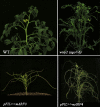Why wiry? Tomato mutants reveal connections among small RNAs, auxin response factors, virus infection, and leaf morphology
- PMID: 23001038
- PMCID: PMC3480282
- DOI: 10.1105/tpc.112.240911
Why wiry? Tomato mutants reveal connections among small RNAs, auxin response factors, virus infection, and leaf morphology
Figures

Comment on
-
Failure of the tomato trans-acting short interfering RNA program to regulate AUXIN RESPONSE FACTOR3 and ARF4 underlies the wiry leaf syndrome.Plant Cell. 2012 Sep;24(9):3575-89. doi: 10.1105/tpc.112.100222. Epub 2012 Sep 21. Plant Cell. 2012. PMID: 23001036 Free PMC article.
Similar articles
-
Failure of the tomato trans-acting short interfering RNA program to regulate AUXIN RESPONSE FACTOR3 and ARF4 underlies the wiry leaf syndrome.Plant Cell. 2012 Sep;24(9):3575-89. doi: 10.1105/tpc.112.100222. Epub 2012 Sep 21. Plant Cell. 2012. PMID: 23001036 Free PMC article.
-
Dicer-like2b suppresses the wiry leaf phenotype in tomato induced by tobacco mosaic virus.Plant J. 2023 Dec;116(6):1737-1747. doi: 10.1111/tpj.16462. Epub 2023 Sep 11. Plant J. 2023. PMID: 37694805
-
LYRATE is a key regulator of leaflet initiation and lamina outgrowth in tomato.Plant Cell. 2009 Oct;21(10):3093-104. doi: 10.1105/tpc.109.069948. Epub 2009 Oct 9. Plant Cell. 2009. PMID: 19820188 Free PMC article.
-
The many roles of small RNAs in leaf development.J Genet Genomics. 2010 Jan;37(1):13-21. doi: 10.1016/S1673-8527(09)60021-7. J Genet Genomics. 2010. PMID: 20171574 Review.
-
RNA commutes to work: regulation of plant gene expression by systemically transported RNA molecules.Bioessays. 2001 Dec;23(12):1087-90. doi: 10.1002/bies.10027. Bioessays. 2001. PMID: 11746226 Review.
Cited by
-
Genome-Wide Identification and Analysis of Auxin Response Factor Transcription Factor Gene Family in Populus euphratica.Plants (Basel). 2025 Apr 19;14(8):1248. doi: 10.3390/plants14081248. Plants (Basel). 2025. PMID: 40284135 Free PMC article.
-
Phenotypic and genetic characterization of tomato mutants provides new insights into leaf development and its relationship to agronomic traits.BMC Plant Biol. 2019 Apr 15;19(1):141. doi: 10.1186/s12870-019-1735-9. BMC Plant Biol. 2019. PMID: 30987599 Free PMC article.
-
Virus-induced phytohormone dynamics and their effects on plant-insect interactions.New Phytol. 2021 May;230(4):1305-1320. doi: 10.1111/nph.17261. Epub 2021 Mar 19. New Phytol. 2021. PMID: 33555072 Free PMC article. Review.
References
-
- Lesley J.W., Lesley M.M. (1928). The “wiry” tomato. A recessive mutant form resembling a plant affected with mosaic disease. J. Hered. 8: 337–344
-
- Rubio-Somoza I., Cuperus J.T., Weigel D., Carrington J.C. (2009). Regulation and functional specialization of small RNA-target nodes during plant development. Curr. Opin. Plant Biol. 12: 622–627 - PubMed
-
- Yifhar T., Pekker I., Peled D., Friedlander G., Pistunov A., Sabban M., Wachsman G., Alvarez J.P., Amsellem Z., Eshed Y. (2012). Failure of the tomato trans-acting short interfering RNA program to regulate AUXIN RESPONSE FACTOR3 and ARF4 underlies the wiry leaf syndrome. Plant Cell 24: 3575–3589 - PMC - PubMed
Publication types
MeSH terms
Substances
LinkOut - more resources
Full Text Sources

